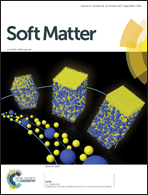A novel supramolecular polymer gel based on naphthalimide functionalized-pillar[5]arene for the fluorescence detection of Hg2+ and I− and recyclable removal of Hg2+via cation–π interactions†
Abstract
The development of novel materials for the detection and removal of Hg2+ is a very important issue due to the acute toxicity of Hg2+. Herein, a novel supramolecular polymer P5BD–DPHB has been constructed by the collaboration of a naphthalimide functionalized-pillar[5]arene host (P5BD) and a bis-bromohexane functionalized-pillar[5]arene guest (DPHB). P5BD–DPHB could form a stable supramolecular gel (P5BD–DPHB–G). Interestingly, P5BD–DPHB–G shows selective fluorescent “turn-on” detection for Hg2+via cation–π interactions with high selectivity and sensitivity. Furthermore, the Hg2+ coordinated supramolecular gel P5BD–DPHB–HgG can detect I− successively. The detection limits for Hg2+ and I− are 1.65 × 10−9 and 1.84 × 10−8 mol L−1, respectively. Even more significantly, the xerogel of P5BD–DPHB–G could remove Hg2+ from aqueous solution with excellent recyclability and ingestion capacity, and with a Hg2+ removal rate of 98%.
![Graphical abstract: A novel supramolecular polymer gel based on naphthalimide functionalized-pillar[5]arene for the fluorescence detection of Hg2+ and I− and recyclable removal of Hg2+via cation–π interactions](/en/Image/Get?imageInfo.ImageType=GA&imageInfo.ImageIdentifier.ManuscriptID=C7SM01447C&imageInfo.ImageIdentifier.Year=2017)


 Please wait while we load your content...
Please wait while we load your content...